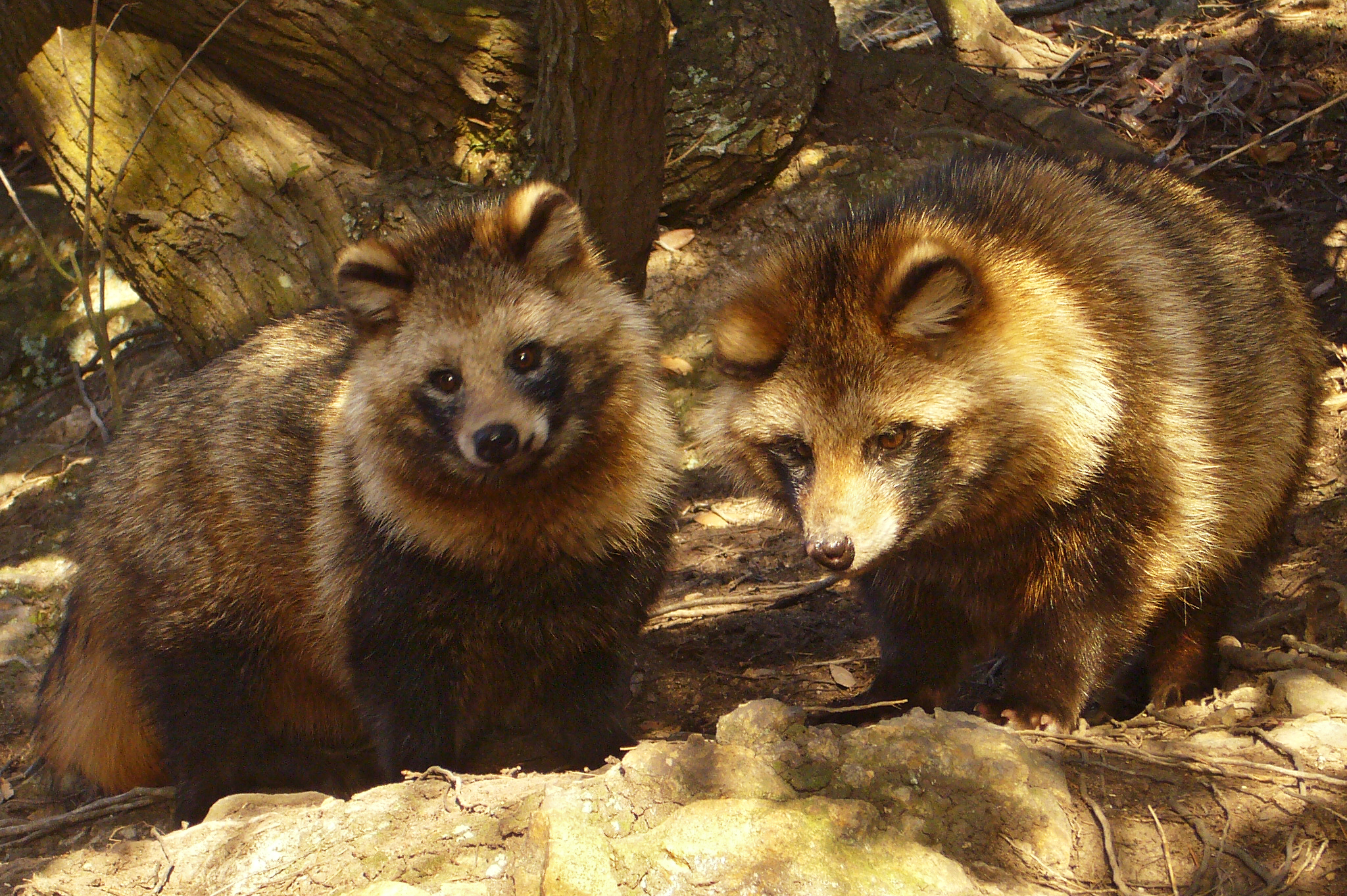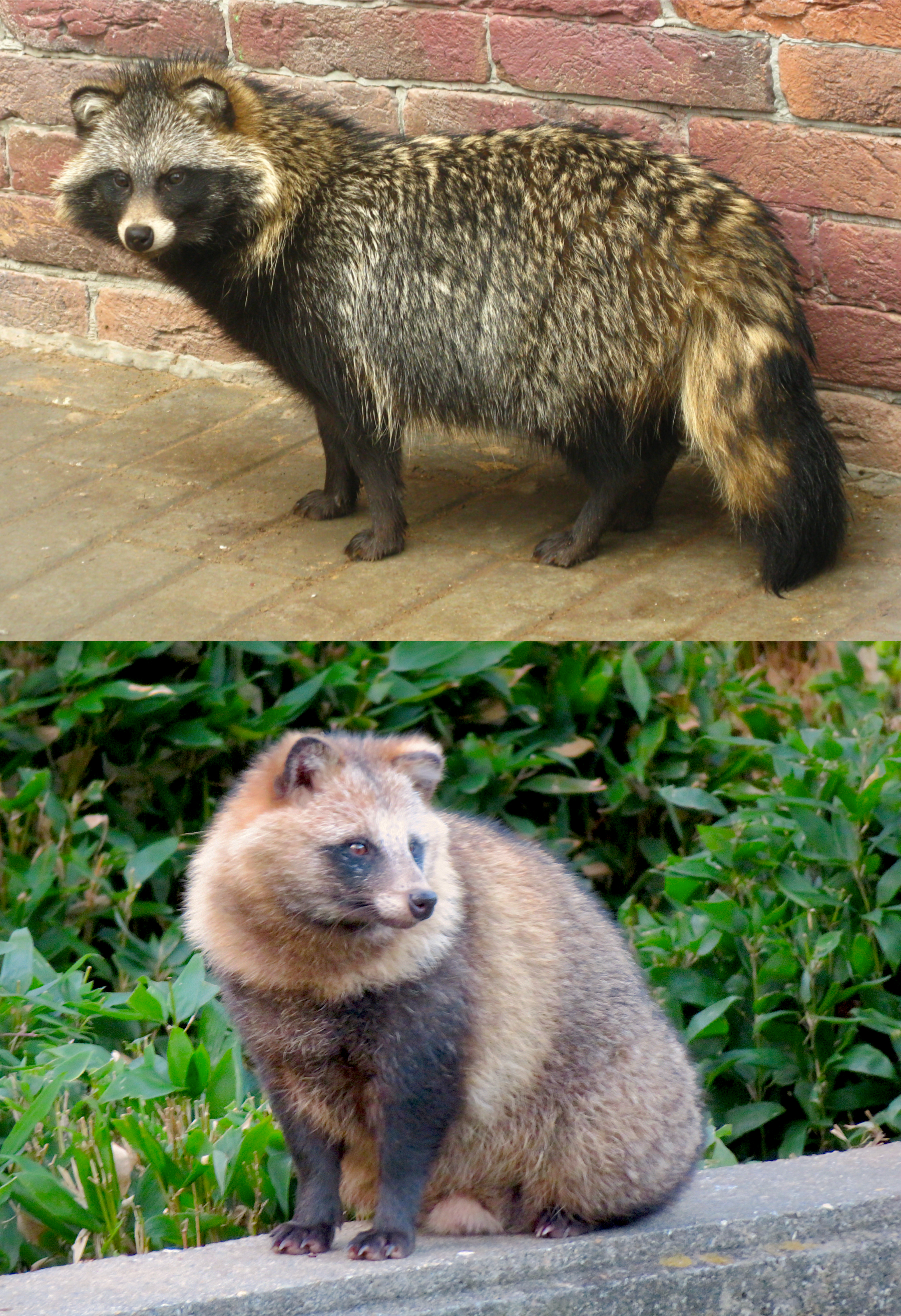Raccoon Dog: Difference between revisions
mNo edit summary |
No edit summary |
||
| (17 intermediate revisions by 9 users not shown) | |||
| Line 1: | Line 1: | ||
{{FriendBox | {{FriendBox | ||
|name=Raccoon Dog | |name=Raccoon Dog | ||
|originalpic=Raccoon DogOriginal. | |originalpic=Raccoon DogOriginal.png | ||
|aka=Tanuki | |aka=Tanuki | ||
|name_jp=タヌキ | |name_jp=タヌキ | ||
| Line 9: | Line 9: | ||
|distribution=East Asia | |distribution=East Asia | ||
|diet=Omnivore | |diet=Omnivore | ||
|lifespan=6-11 Years | |||
|wikilink=[[wikipedia:Raccoon dog|Raccoon dog]] | |wikilink=[[wikipedia:Raccoon dog|Raccoon dog]] | ||
|conservationstatus={{LC}} | |conservationstatus={{LC}} | ||
}} | }} | ||
{{FriendBuilder | {{FriendBuilder | ||
|introduction= | |introduction={{quote|Order carnivora, family canidae, I'm Raccoon Dog. Uh, uhm, Raccoon Dog spends her life forever with the partner she has chosen... Ah, that's why, uhm... ... You understand what I mean right? You understand right?|Raccoon Dog's Introduction.}}The '''Raccoon Dog''' is a type of mammal [[Friend]] that debuted in the original [[Kemono Friends (2015 Mobile Game)|Kemono Friends mobile game]] and has appeared in the [[Kemono Friends: Welcome to Japari Park!|Welcome to Japari Park!]] manga. She has also appeared in the first [[Stage Play "Kemono Friends"|Kemono Friends Stage Play]] and has since appeared in [[Kemono Friends Pavilion]], the [[Kemono Friends 2|second season]] of the Kemono Friends anime, and [[Kemono Friends 3]]. | ||
|appearance=Raccoon Dog has black and white hair. Her hair fades into white at the behind, and has the same pattern that can be seen in a raccon dog's face at the front. | |appearance=Raccoon Dog has black and white hair. Her hair fades into white at the behind, and has the same pattern that can be seen in a raccon dog's face at the front. | ||
She has brown | She has brown irises with highlights, indicating her animal species is not extinct. | ||
She has a white furred collar and a blue ''serafuku'', with a white ribbon - she also has black furred gloves, grayish-beige stockings that fade into black, and black shoes. | She has a white furred collar and a blue ''serafuku'', with a white ribbon - she also has black furred gloves, grayish-beige stockings that fade into black, and black shoes. | ||
She has the tail and ears of a raccoon dog. | |||
|reallife=[[File:Nyctereutes.png|thumb|left|A Common (top) and Japanese (bottom) Raccoon dog. Photos by [https://commons.wikimedia.org/wiki/User:%D0%94%D0%BE%D0%BA%D1%82%D0%BE%D1%80_%D1%80%D1%83%D0%BA%D0%B8%D0%BD%D0%BE%D0%B3%D0%B8 Доктор рукиноги] and [https://commons.wikimedia.org/wiki/User:KKPCW KKPCW].]] | |||
The Raccoon Dog comes from the genus ''[https://en.wikipedia.org/wiki/Nyctereutes Nyctereutes]'', a subspecies of the [https://en.wikipedia.org/wiki/Canid Canid] family. The family includes only two extant species, ''Nyctereutes procyonoides'' (Common Raccoon Dog) and ''Nyctereutes viverrinus'' (Japanese Raccoon Dog). | |||
Given the significance of the Raccoon Dog in Japanese culture and mythology, it's very likely that one was the reference for this Friend. | |||
The Japanese Raccoon Dog, also known as the ''tanuki'', are endemic to Japan and are smaller than their Common Raccoon Dog cousins. They are typically nocturnal but can be seen out in the daytime on occasion. When vocalizing, they can sound like domesticated house cats with growling and high-pitched groaning. Also like cats, the Japanese Raccoon Dog will arch their backs to appear intimidating to foes. However, like domesticated dogs, they will roll onto their backs and go "belly up" when showing submissiveness. | |||
The species is predominantly monogamous, though not particularly social. Groups are usually limited to a single breeding pair. However an individual Japanese Raccoon Dog may stay in a small group of non-mated dogs until they find their own mate. The breeding period is between February and April and is synched between the male and female. After a gestation period of around 9 weeks, a litter of four to six pups are born. The parents will care for the pups for around a month, and then an additional month after the babies leave the den. | |||
[[File:Der Marderhund, Tanuki oder Enok (Nyctereutes procyonoides), bitte nicht zu verwechseln mit einem Waschbär, hier im Wisentgehege in Springe (Kleiner Deister).jpg|thumb|left|The distinctly raccoon-like markings of a raccoon dog's face. Photo by [https://de.wikipedia.org/wiki/Benutzer:Bernd_Schwabe_in_Hannover Bernd Schwabe in Hannover].]] | |||
Tanuki have had a significant role in [https://en.wikipedia.org/wiki/Japanese_folklore Japanese Folklore] since the ancient times. In their legendary myths, they are known to be [https://en.wikipedia.org/wiki/Shapeshifting shapeshifters] and masters of disguise. They are also known to be "mischievous and jolly", but also rather gullible. [https://en.wikipedia.org/wiki/Bake-danuki ''Bake-danuki''] (化け狸) are a type of tanuki [https://en.wikipedia.org/wiki/Y%C5%8Dkai yōkai] (supernatural spirits) found all throughout stories and lore. The earliest appearance of the bake-danuki in literature was in [https://en.wikipedia.org/wiki/Nihon_Shoki ''Nihon Shoki''] (''The Chronicles of Japan'') in the chapter about [https://en.wikipedia.org/wiki/Empress_Suiko Empress Suiko]. One passage says ''"...in two months of spring, there are tanuki in the country of Mutsu, they turn into humans and sing songs."'' | |||
Not limited to ancient folklore, Japanese Raccoon Dogs are also quite popular in current pop culture. Some more notable features include the "[https://www.mariowiki.com/Tanooki_Suit Tanooki Suit]" in the ''Super Mario'' franchise, [https://animalcrossing.fandom.com/wiki/Tom_Nook Tom Nook] and his nephews Timmy and Tommy in the ''Animal Crossing'' franchise, the 1994 Studio Ghibli film [https://en.wikipedia.org/wiki/Pom_Poko Pom Poko], and Michiru Kagemori in the 2020 anime [https://en.wikipedia.org/wiki/BNA:_Brand_New_Animal BNA: Brand New Animal]. | |||
[[File:Tanuki01 960.jpg|thumb|upright=1.0|right|Two Raccoon Dogs in Fukuyama, Hiroshima Prefecture, Japan. Photo by [https://commons.wikimedia.org/wiki/File:Tanuki01_960.jpg 663highland], 2006.]] | |||
|trivia=* As of around 2010, there are seven extinct species in the family. | |||
* The Raccoon Dog is considered one of the earliest canines to arrive in the Old World. | |||
* The oldest recorded fossil dates back around 5.5 million years ago (MYA) | |||
* While their coats are typically brown and black, a very rare white variant has been seen at least once. | |||
* Japanese Raccoon Dogs are referred to as Tanuki in media from their home country, whereas overseas they are often referred to simply as Raccoons. | |||
|reference=* [https://en.wikipedia.org/wiki/Nyctereutes Nyctereutes Wikipedia page] | |||
* [https://en.wikipedia.org/wiki/Common_raccoon_dog Common Raccoon Dog Wiki Page] | |||
* [https://en.wikipedia.org/wiki/Japanese_raccoon_dog Japanese Raccoon Dog Wiki Page] | |||
* Ishibashi, Ohdachi; Saitoh, Iwasa (July 2009). The Wild Mammals of Japan. pp. 216–217. | |||
* Dōbutsu Yōkaitan. Vol. 2. pp. 105–139. | |||
* Tanuki to sono sekai. pp. 209–212. | |||
* Gensō sekai no jūnintachi. pp. 235–240. | |||
* [http://www.japantimes.co.jp/news/2013/10/18/national/rare-white-raccoon-dog-caught/ "Rare white raccoon dog caught"]. The Japan Times. 18 October 2013. Archived from the original on 3 August 2021. Retrieved 17 August 2021. | |||
}} | }} | ||
{{MammalFriendsNav}} | {{MammalFriendsNav}} | ||
[[Category:Real Animal Friends]] [[Category:Mammal Friends]] [[Category:Canid Friends]] [[Category:Nexon Game Debuts]] | |||
Revision as of 17:22, 27 October 2023
Raccoon Dog
| |||
|---|---|---|---|
| タヌキ | |||
| Character Data | |||
| AKA | Tanuki
| ||
| Romaji | tanuki
| ||
| Debut | Kemono Friends (2015 Game) | ||
| Animal Data | |||
| Scientific Name | Nyctereutes procyonoides
| ||
| Distribution | East Asia
| ||
| Diet | Omnivore
| ||
| Avg. Lifespan | 6-11 Years
| ||
| Read More | Raccoon dog
| ||
| Conservation | 
| ||
| Raccoon Dog | Season 2 | Manga | Festival | Pavilion | KF3 | Nexon Game | Stage Play | Gallery |
“Order carnivora, family canidae, I'm Raccoon Dog. Uh, uhm, Raccoon Dog spends her life forever with the partner she has chosen... Ah, that's why, uhm... ... You understand what I mean right? You understand right?”
—Raccoon Dog's Introduction.
The Raccoon Dog is a type of mammal Friend that debuted in the original Kemono Friends mobile game and has appeared in the Welcome to Japari Park! manga. She has also appeared in the first Kemono Friends Stage Play and has since appeared in Kemono Friends Pavilion, the second season of the Kemono Friends anime, and Kemono Friends 3.
Appearance
Raccoon Dog has black and white hair. Her hair fades into white at the behind, and has the same pattern that can be seen in a raccon dog's face at the front. She has brown irises with highlights, indicating her animal species is not extinct. She has a white furred collar and a blue serafuku, with a white ribbon - she also has black furred gloves, grayish-beige stockings that fade into black, and black shoes. She has the tail and ears of a raccoon dog.
Series Appearances
| Media | Role | |
|---|---|---|
In Real Life
The Raccoon Dog comes from the genus Nyctereutes, a subspecies of the Canid family. The family includes only two extant species, Nyctereutes procyonoides (Common Raccoon Dog) and Nyctereutes viverrinus (Japanese Raccoon Dog).
Given the significance of the Raccoon Dog in Japanese culture and mythology, it's very likely that one was the reference for this Friend.
The Japanese Raccoon Dog, also known as the tanuki, are endemic to Japan and are smaller than their Common Raccoon Dog cousins. They are typically nocturnal but can be seen out in the daytime on occasion. When vocalizing, they can sound like domesticated house cats with growling and high-pitched groaning. Also like cats, the Japanese Raccoon Dog will arch their backs to appear intimidating to foes. However, like domesticated dogs, they will roll onto their backs and go "belly up" when showing submissiveness.
The species is predominantly monogamous, though not particularly social. Groups are usually limited to a single breeding pair. However an individual Japanese Raccoon Dog may stay in a small group of non-mated dogs until they find their own mate. The breeding period is between February and April and is synched between the male and female. After a gestation period of around 9 weeks, a litter of four to six pups are born. The parents will care for the pups for around a month, and then an additional month after the babies leave the den.

Tanuki have had a significant role in Japanese Folklore since the ancient times. In their legendary myths, they are known to be shapeshifters and masters of disguise. They are also known to be "mischievous and jolly", but also rather gullible. Bake-danuki (化け狸) are a type of tanuki yōkai (supernatural spirits) found all throughout stories and lore. The earliest appearance of the bake-danuki in literature was in Nihon Shoki (The Chronicles of Japan) in the chapter about Empress Suiko. One passage says "...in two months of spring, there are tanuki in the country of Mutsu, they turn into humans and sing songs."
Not limited to ancient folklore, Japanese Raccoon Dogs are also quite popular in current pop culture. Some more notable features include the "Tanooki Suit" in the Super Mario franchise, Tom Nook and his nephews Timmy and Tommy in the Animal Crossing franchise, the 1994 Studio Ghibli film Pom Poko, and Michiru Kagemori in the 2020 anime BNA: Brand New Animal.

Trivia
- As of around 2010, there are seven extinct species in the family.
- The Raccoon Dog is considered one of the earliest canines to arrive in the Old World.
- The oldest recorded fossil dates back around 5.5 million years ago (MYA)
- While their coats are typically brown and black, a very rare white variant has been seen at least once.
- Japanese Raccoon Dogs are referred to as Tanuki in media from their home country, whereas overseas they are often referred to simply as Raccoons.
References
- Nyctereutes Wikipedia page
- Common Raccoon Dog Wiki Page
- Japanese Raccoon Dog Wiki Page
- Ishibashi, Ohdachi; Saitoh, Iwasa (July 2009). The Wild Mammals of Japan. pp. 216–217.
- Dōbutsu Yōkaitan. Vol. 2. pp. 105–139.
- Tanuki to sono sekai. pp. 209–212.
- Gensō sekai no jūnintachi. pp. 235–240.
- "Rare white raccoon dog caught". The Japan Times. 18 October 2013. Archived from the original on 3 August 2021. Retrieved 17 August 2021.

